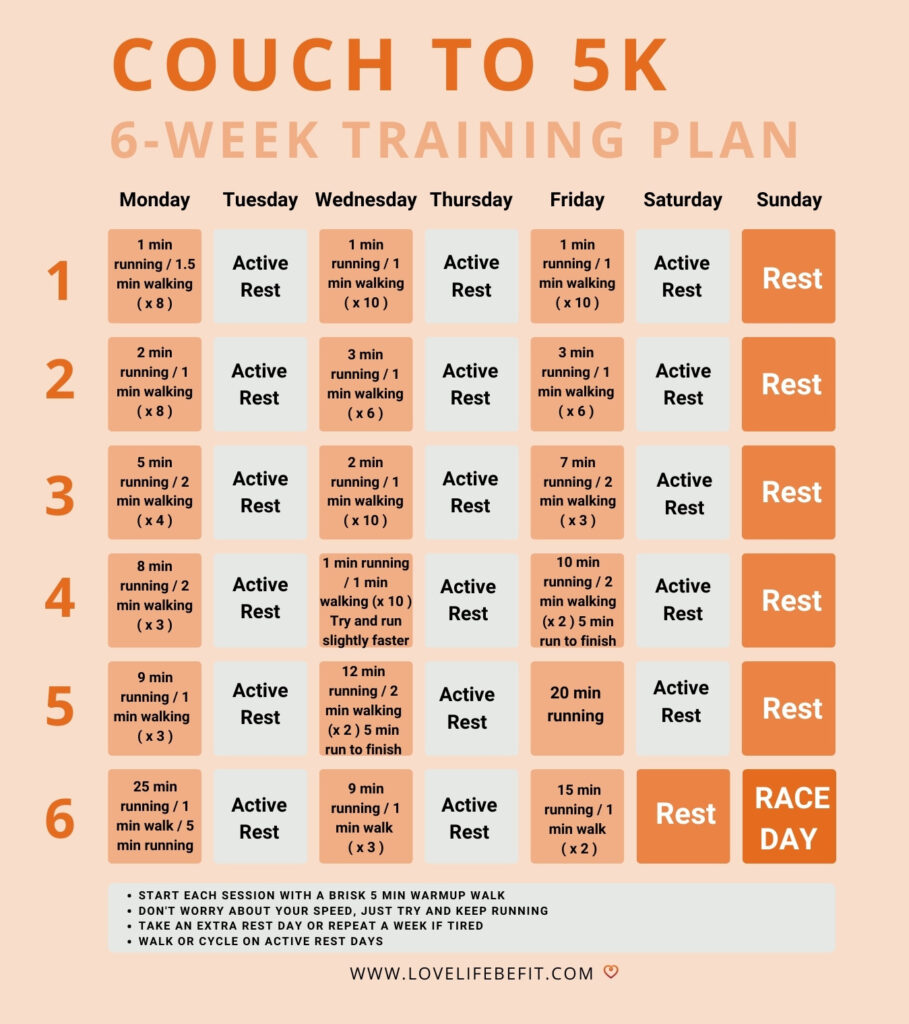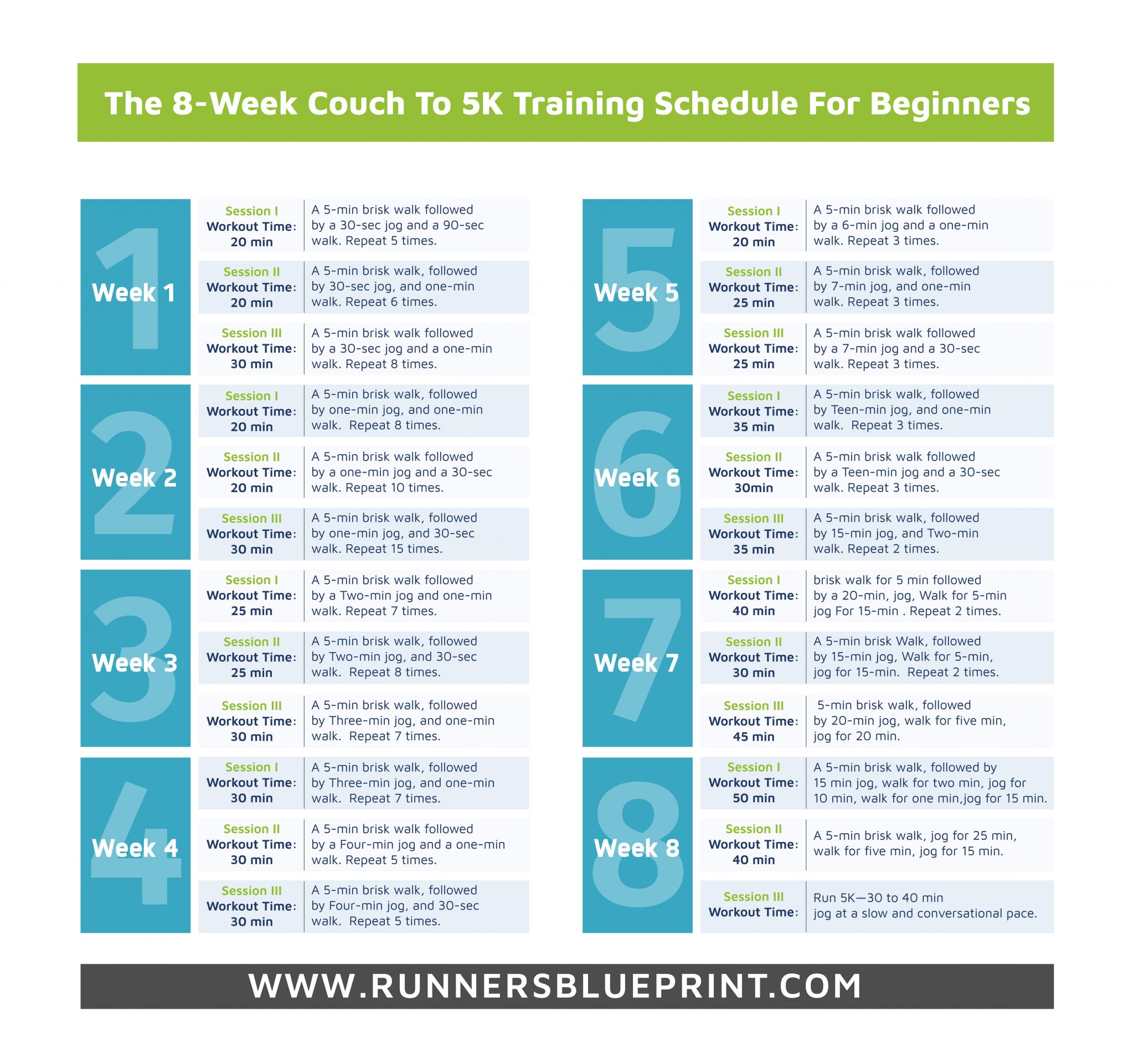What is the Couch to 5k Training Schedule?
The Couch to 5k training schedule is a popular running program designed specifically for beginners. Its primary purpose is to help individuals gradually build their running endurance, enabling them to complete a 5k race (3.1 miles) without stopping. This program typically spans nine weeks, with three workouts per week. The structure ensures a steady progression, allowing participants to safely and comfortably increase their running distance and duration.
The Couch to 5k training schedule caters to individuals with little to no running experience, making it an ideal starting point for those looking to improve their fitness levels, lose weight, or simply embrace a healthier lifestyle. The program’s gradual progression significantly reduces the risk of injury, making it accessible to a wide range of fitness levels and ages.
Why Choose the Couch to 5k Training Schedule?
The Couch to 5k training schedule offers numerous benefits for beginners looking to improve their running abilities and overall fitness levels. This program emphasizes injury prevention and gradual progression, making it an excellent choice for those with little to no running experience.
One of the primary advantages of the Couch to 5k training schedule is its focus on injury prevention. By gradually increasing the duration and intensity of workouts, the program minimizes the risk of common running injuries, such as shin splints and stress fractures. This structured approach ensures that beginners can safely build their running endurance without pushing their bodies too hard, too quickly.
Additionally, the Couch to 5k training schedule fosters a sense of gradual progression, allowing participants to see tangible improvements in their running abilities over time. This progression can significantly boost motivation and self-confidence, encouraging beginners to stick with the program and achieve their running goals. Furthermore, the program’s structure helps participants develop a consistent running routine, which can lead to long-term habit formation and improved overall health.
How to Get Started with the Couch to 5k Training Schedule
Embarking on the Couch to 5k training schedule is an exciting journey! To begin, follow these steps to ensure a successful start:
- Set clear goals: Define your objectives, such as completing a 5k race or improving your overall fitness level. Having specific goals will help keep you motivated and focused throughout the training schedule.
- Choose the right running shoes: Invest in a good pair of running shoes that provide adequate support and cushioning for your feet. Consider visiting a specialty running store for a professional fitting to ensure you find the perfect pair for your foot type and running style.
- Find a suitable running location: Select a safe and enjoyable running location, such as a local park, trail, or neighborhood. A change of scenery can make your runs more interesting and enjoyable.
- Warm-up and cool-down: Before each workout, perform a dynamic warm-up, such as leg swings, lunges, and high knees, to prepare your muscles for exercise. After your run, cool down with static stretches to help reduce muscle soreness and improve flexibility.
- Stay consistent: Aim to complete three workouts per week, allowing for rest days in between. Consistency is key to building your running endurance and achieving your goals.
The Couch to 5k Training Schedule: A Week-by-Week Breakdown
The Couch to 5k training schedule is structured into nine weeks, with three workouts per week. This progressive plan gradually increases the duration and intensity of each workout, allowing beginners to build their running endurance safely and effectively.
- Weeks 1-2: Begin with a mix of walking and running intervals, gradually increasing the running time while decreasing the walking time.
- Weeks 3-5: Continue to increase the running time while decreasing the walking time. Introduce longer running intervals to challenge your endurance.
- Weeks 6-8: Focus on building your running stamina by running for longer periods without walking breaks. Include interval training to improve speed and strength.
- Week 9: Consolidate your progress with a combination of longer runs and interval training. Prepare for your final 5k race by practicing pacing and breathing techniques.
Rest days are crucial in the Couch to 5k training schedule, as they allow your muscles to recover and rebuild. Incorporate cross-training activities, such as swimming, cycling, or yoga, on your rest days to maintain overall fitness and prevent injury.
Staying Motivated During Your Couch to 5k Journey
Staying motivated throughout the Couch to 5k training schedule can be challenging, but several strategies can help you maintain your commitment and enthusiasm:
- Find an accountability partner: Partner with a friend, family member, or co-worker who is also following the Couch to 5k training schedule. By sharing your progress and setbacks, you can provide mutual support and encouragement.
- Track your progress: Keep a training log or use a fitness app to record your workouts, distances, and times. Seeing your improvements over time can be a powerful motivator and help you stay focused on your goals.
- Celebrate milestones: Acknowledge and reward your achievements as you progress through the training schedule. Whether it’s a new personal best or simply completing a workout, take time to celebrate your successes and reinforce your commitment to the program.
- Mix up your workouts: Incorporate variety into your training routine by trying new running routes, participating in group runs, or engaging in other physical activities you enjoy. This can help prevent boredom and keep your motivation levels high.
- Stay positive: Maintain a positive attitude, even when faced with setbacks or challenges. Remember that progress takes time and that every step, no matter how small, brings you closer to your goal of completing a 5k race.
Troubleshooting Common Challenges in the Couch to 5k Training Schedule
Even with the best intentions and preparation, beginners may encounter various challenges during the Couch to 5k training schedule. Here are some common obstacles and potential solutions:
- Fatigue: If you find yourself excessively tired during or after workouts, reassess your sleep habits, nutrition, and hydration. Ensure you are getting adequate rest, consuming a balanced diet, and staying hydrated. Consider adjusting your workout schedule to allow for more recovery time between sessions.
- Boredom: To combat boredom, mix up your running routes, listen to music or podcasts, or engage in social runs with others. Incorporating variety can help keep your workouts interesting and enjoyable.
- Injuries: If you experience pain or discomfort during or after a workout, take a break and assess the situation. It may be necessary to rest, ice, compress, and elevate the affected area. If pain persists, consult a medical professional for further guidance. To prevent injuries, always warm up before workouts, cool down afterward, and gradually increase the intensity and duration of your runs.
By acknowledging and addressing these challenges, you can maintain your progress and successfully complete the Couch to 5k training schedule.
Transitioning from Couch to 5k to Longer Distances
Congratulations on completing the Couch to 5k training schedule! You’ve built a solid foundation of running endurance, and you may be wondering what’s next. For many runners, the natural progression is to tackle longer distances, such as a 10k, half marathon, or even a full marathon. Here’s how to continue your running journey:
- Assess your readiness: Before increasing your distance, ensure you’re physically and mentally prepared. Reflect on your Couch to 5k experience and consider any areas for improvement, such as nutrition, hydration, or recovery strategies.
- Choose a training plan: Select a training plan tailored to your desired distance and goals. Many resources are available online, offering plans for various abilities and timeframes. Look for a plan that gradually increases distance and intensity, includes rest days, and incorporates cross-training activities.
- Set new goals: Establish specific, measurable, achievable, relevant, and time-bound (SMART) goals for your new running endeavor. Having clear objectives will help keep you motivated and focused throughout your training.
- Monitor your progress: Regularly track your workouts, distances, and times to evaluate your progress and make adjustments as needed. This information can help you identify strengths and weaknesses, allowing you to fine-tune your training approach.
- Stay consistent: Consistency is crucial when transitioning to longer distances. Aim to complete workouts as scheduled, but be flexible and willing to adjust if needed. Life happens, and understanding that setbacks are a natural part of the process can help you maintain a positive attitude and stay committed to your running journey.
Frequently Asked Questions About the Couch to 5k Training Schedule
Here are some of the most common questions about the Couch to 5k training schedule, along with answers to help guide beginners on their running journey:
What is the ideal running pace during the Couch to 5k training schedule?
The Couch to 5k training schedule is designed to build running endurance gradually, so it’s essential to maintain a comfortable pace. Aim for a speed that allows you to hold a conversation while running. As your fitness improves, you’ll naturally become faster.
Do I need to warm up and cool down during the Couch to 5k training schedule?
Yes, warming up and cooling down are crucial components of any exercise routine, including the Couch to 5k training schedule. A proper warm-up prepares your muscles for activity, reduces the risk of injury, and improves performance. A cool-down helps your body recover and reduces muscle soreness. Incorporate dynamic stretches, such as leg swings and lunges, for your warm-up and static stretches, like toe touches and quad stretches, for your cool-down.
What role does nutrition play in the Couch to 5k training schedule?
Nutrition plays a significant role in running performance and overall health. Consuming a balanced diet with adequate carbohydrates, proteins, and fats can help fuel your workouts, support muscle recovery, and maintain energy levels. Stay hydrated by drinking water before, during, and after runs. Additionally, consider incorporating nutrient-dense foods, such as fruits, vegetables, whole grains, lean proteins, and healthy fats, into your diet.









